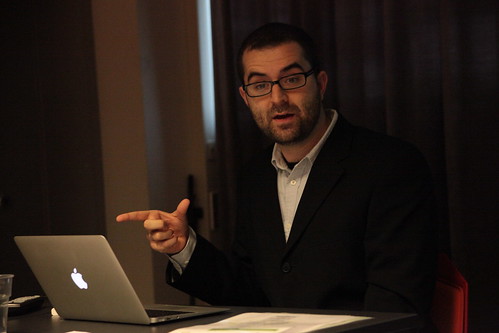During the pre-conference about open video held at the media park in Hilversum, Ben Moskowitz, the general coordinator of the Open Video Alliance, presented his thoughts for an “open” video ecosystem by bringing technology, institutions and databases of video’s together to make video on the web accessible, distributable, searchable and exchangeable. The open video alliance is a coalition of organizations and individuals devoted to creating and promoting free and open technologies, policies, and practices in online video.
Ben Moskowitz argues that we need an alternative for the video-on-demand technology we have today. These technologies are often proprietary, such as Realplayer in the early days of the web or the Flash video nowadays. Also, videos are not connected to the rest of the web. For example, you can link and embed YouTube videos but the content is disconnected, it’s a Flash element in a website as a static black box. Furthermore, these technologies don’t allow the audience to get really involved or engage with the content, much like on you tube where there’s no real option for conversations in the comments. His primary complaint about current web video technology is that there’s now the ability to extend the content within the video to the rest of the web.
Open technologies are critical for continuous innovation, especially with web video. The combination of open technology and best practices allows distributors to create a configurable space on which the content of videos is connected to sources outside of the video. The web allows for such technology by reconfiguring and reshaping traditional analog technologies, remediating them, and enhancing their functionality as they are freed form packaging, video containers, and channels. With the arrival of HTML-5, technologies such as JavaScript, the use of open standards, and open API’s allow for new designs, which can be exploited to the ends of the distributor.
The arrival of HTML5 is an especially important development for Moskowitz since it makes video a first-class citizen on websites. He refers to the Mozilla Drumbeat project which supports open web initiatives. As described on their website the open web is participatory, transparent, decentralized and generative. Existing content and software can easily be spun into something new. A great example of this belief and web video is the Popcorn.js project, which allows a mash up of video and open API technology, which essentially connects content from around the web with the content inside the video. The Popcorn JavaScript can show and connect multiple elements from websites such as Wikipedia, Twitter, and Flickr. It triggers these elements based on the content in the video, which makes it much more dynamic as it extends the range and reach of video and allows the public to engage on different paths. As Moskovitz describes it “It’s a webpage and not a crappy flash video, the potential for weaving video into the web is going to be amazing”.
Another tool to make online video more accessible and searchable is the Universal Subtitles project which offers a tool to transcribe a video and connect to a larger community allowing translations of multiple languages. By doing so the content becomes searchable by the transcript. Another option for making video more searchable is the use of extensive metadata about the video. As an example, Moskovitz shows Metavid.org that contains a database of US Congress videos, which are searchable by the speakers name, the spoken text, the date, and metadata from outside sources.
To conclude, Ben Moskovitz advocates an open web standard for video so that the video weaves into the web pages just as images and text. Open technology is more flexible and adaptable, and by using open licensed media the content becomes more fluid. By combining these two, the web content can be, distributed, reused, adapted, and shared more effectively. For public broadcasters he advices to “embrace the commons” as he quotes Eirik Solheim from NRK (Norwegian Broadcasting Corporation) “you can’t be the only provider of your content but you can be the best provider of your content”.
How better to explain open video than by a video itself from the Open Video Conference (No HTML5):
Video from Blip.tv http://blip.tv/file/4227236


